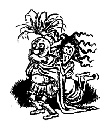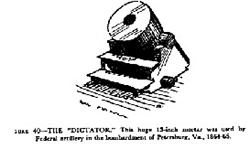 With the summer trip season upon us, and a great deal of interest shown in battlefield visits we've reprinted this Cry "Havoc!" #1 article for the numerous subscribers who never saw it.
With the summer trip season upon us, and a great deal of interest shown in battlefield visits we've reprinted this Cry "Havoc!" #1 article for the numerous subscribers who never saw it.
I like history. I really do. The past is as attractive to me as it is to my husband. I'm just not a fanatic about it. I prefer my history in smaller doses and on different subjects. (For some reason I can never get my husband to show the same enthusiasm for the history of music or genealogy that he does for military affairs.)
Military battlefields do cause a great deal of excitement in the wargamer. First, he can actually see the "lay of the land." Second he can reflect on the reality of his paper map and counters. Third, admission is usually free or, when there are charges, inexpensive. Hence, a visit to a battlefield should make for an ideal destination for a family trip - Right? Well — sort of.
In our travels I've found myself on a great many battlefields with two kids (now aged 11 and 4). Its fun for awhile, but then we reach the saturation point, just as Dad is hitting his stride. The kids and I exchange looks. Whose going to tell him we want to leave? Who wants to be bored on battlefield? Who wants to see glazed looks and hear whining kids when they're having fun? Now what? My husband is fond of stating that planning is an important part of warfare. Its also as important in preventing a battlefield trip from turning into a fiasco. Before the family departs, someone — usually MOM — needs to create enthusiasm in the children (Dads seem to assume enthusiasm).
The first stop is the library. Children's books cover every conceivable topic and there's usually one on written especially for children on the particular battle. The children's librarian can be a well of information on other books that might be of value. After getting the books home the first thing I do is read the stories to our youngest. For the young child it means that this is not only important to Dad and Mom, but to him too. Besides, I usually learn something. Older children can usually be given books that they can follow, and which are geared for schoolaged children.
Another place to look is video stores. Sometimes there is a film about a child (or cartoon character) during the same era, if not the actual battle. "Glory!" may be a bit gory, but "The Drummer Boy of Shiloh" is appropriate and just as informative. Now that the "intelligence" portion of the planning is done, its time to worry about logistics. Generally prices for food and drinks near or at the destination are "touristy" — a polite way of saying grossly inflated. Picnic lunches are usually allowed, can be fun and provide a much needed break. I usually pack the food into backpacks. Sooner or later one of the children is going to want to play soldier for awhile and can carry it. Once these items are taken care of its time to depart for our rendezvous with history.
All battlefields administered by the US National Park Service have a visitor's station. Start there — not only is it a chance for the children to get a drink and check out the facilities, but you and your husband can plan your attack. Spend a while looking at any and all displays. A lot of them relate to life of the era as well.
When my youngest's attention wanders, I try to find small items "a dog on a street corner," "someone looking out of the window: or "the number of buttons on the uniform," for him to find either in the display or in the building. The older boy can usually be asked other questions such as "How tall do you think that soldier was." Frequently he sees things we overlook. These "searches" give any child something concrete and specific to think about.
Then, its off to the actual battlefield. Some, like Manassas, are laid out along a pleasant hike with recordings along the way. Most, like Antietam can be readily understood. In the more complex ones such as Petersburg and Gettysburg where battlefield positions shift constantly, the details of the battle may not be fully understood by the kids. Most of the time I have found the children enjoy the battlefield for awhile (in between climbing on every available cannon, war memorial, and statue in sight.) When interest on their part starts to flag its the time for races and more searches — Who can spot the next stop? or Who can reach it first?
 At a convenient stopping point, its time to break out the picnic lunch (by now the backpacks have landed up on our shoulders).
At a convenient stopping point, its time to break out the picnic lunch (by now the backpacks have landed up on our shoulders).
Always check at the visitor's center as to precisely where "eating" is allowed. While munching away on the food, talk to the children about how they would feel if they had lived during that time. Ask them and reeducate them as to why the place they are at is special. Stopping at the gift shop on the way out can be an eye-opening experience. In general we limit what the children can buy to a small item, such as a postcard or poster. Surprisingly most of the time, despite the fact that they give all indication of not hearing a word you say their choices usually capture the pathos, anguish and solemnity of the place. They may be short on the details, but careful groundwork can leave them with the impression that the place is "special."
My personal recommendation, unanimously approved by the children — is no more than one battlefield in any one day. Preferably not even two days in a row — after all, you have to have time to see the other sights in the town.
Back to Cry Havoc #10 Table of Contents
Back to Cry Havoc List of Issues
Back to MagWeb Master Magazine List
© Copyright 1994 by David W. Tschanz.
This article appears in MagWeb (Magazine Web) on the Internet World Wide Web. Other military history articles and gaming articles are available at http://www.magweb.com